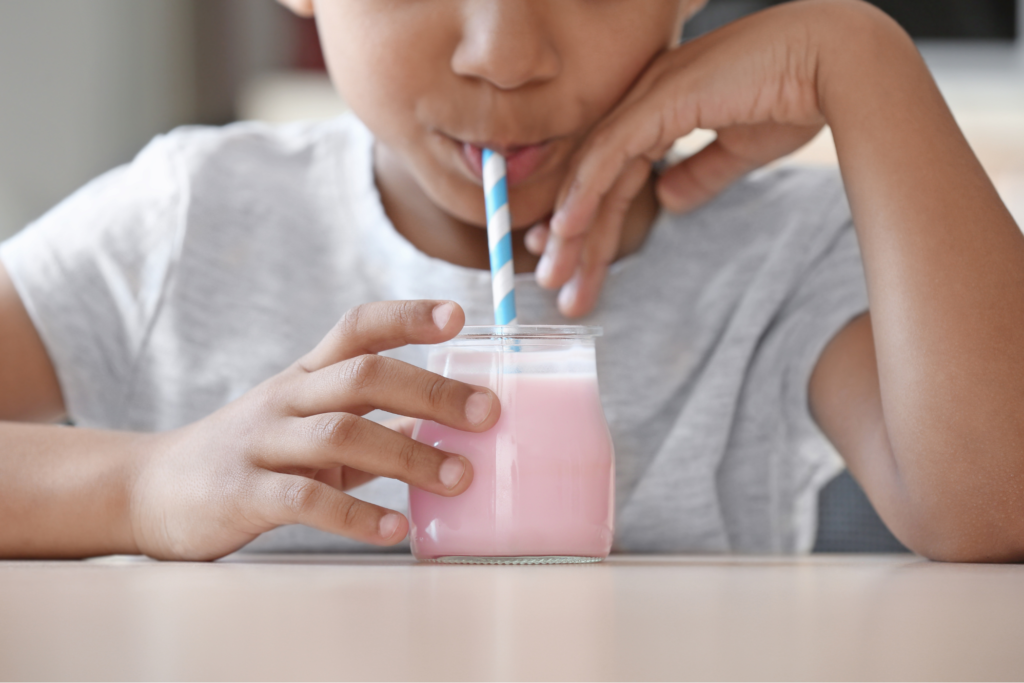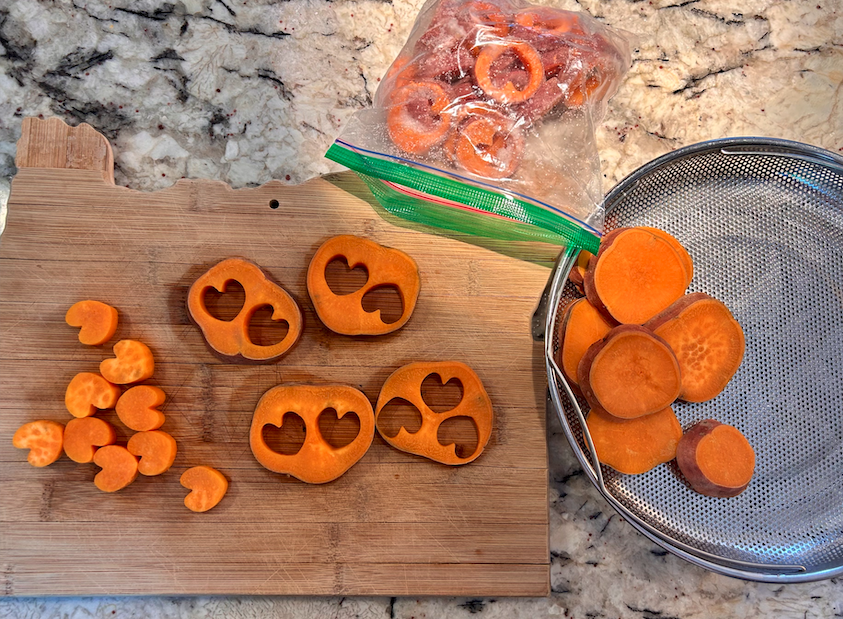
Introduction
Moms everywhere know the challenges of convincing kids to eat their vegetables, which is why smoothies are a fantastic way to sneak in some extra nutrients into your child’s diet, without any pushback.
Our favorite reasons for smoothies? They are:
- Easy to Make: Kids smoothies can be whipped up in a matter of minutes with minimal effort.
- Highly Versatile: They can be made with a variety of fruits, vegetables, and add-ins to suit your child’s preferences.
- Packed with Nutrients: Depending on the ingredients used, each glass can offer an array of vitamins, minerals, and antioxidants.
Below we’ll dive into our top 5 healthy ingredients.
5 Healthy Ingredients to Sneak into Your Kids’ Smoothies
Here are our favorite superfood ingredients that are nutrient-dense, mild in flavor, and a great additional to smoothies.
1. Whole Fat Grass-Fed Greek Yogurt 🥛
- Why It’s a Good Smoothie Ingredient:The creamy texture of Greek yogurt adds richness to smoothies while keeping them filling and satisfying. Plus, its mild flavor easily blends with fruits and other ingredients, making it a versatile choice for busy moms looking to boost their kids’ smoothies with added nutrition.
- Health Benefits: Packed with protein, calcium, and gut-friendly probiotics, whole fat grass-fed Greek yogurt is a nutritional powerhouse for growing kids. These components collectively contribute to bone health, gastrointestinal function, and immune modulation in children.
2. Sweet Potatoes 🍠
- Why It’s a Good Smoothie Ingredient: When steamed and blended into smoothies, sweet potatoes add natural sweetness and a velvety texture. Kids won’t even detect the presence of this nutrient-packed veggie, but they’ll benefit from its nutritional goodness.
- Health Benefits: Sweet potatoes are replete with beta-carotene, vitamin C, fiber, and potassium. These nutrients exert multifaceted effects on vision, immune function, and gastrointestinal health in children.
Pro tip: After thoroughly washing a sweet potato, slice into 1/4 inch coins leaving the skin on. Boil for 5-7min until tender when pierced by a fork. Once cooled, you can cut out shapes using mini cookie cutters like these. Save the outsides in a baggie in the freezer to pop into your next smoothie, reducing food waste!

3. Frozen Avocados 🥑
- Why It’s a Good Smoothie Ingredient: Frozen avocados lend a creamy texture to smoothies while providing a subtle, buttery flavor. Adding avocado to smoothies not only increases their nutritional value but also gives them a creamy texture that kids adore. They’re a great way to sneak in some extra healthy fats and nutrients into your kids’ diet without them even realizing it.
- Health Benefits: Avocado is packed with nutrients, making it perfect for adding to your children’s smoothies. It contains healthy fats, specifically monounsaturated fat, which is important for brain development and can help keep skin healthy. Additionally, avocados are loaded with vitamins C, E, K, and B-6, as well as riboflavin, niacin, folate, pantothenic acid, magnesium, and potassium. They also provide lutein, beta-carotene, and omega-3 fatty acids.
Pro tip: if you have ripe avocados, instead of making a batch of guacamole, cut them into chunks and stash in the freezer in pre-portioned baggies. That way, they’re ready to pop into smoothies!
4. Nutso Brand Spread or Other High Quality Nut & Seed Spreads 🥜
- Why It’s a Good Smoothie Ingredient: Nut and seed spreads not only add a delicious nutty flavor to smoothies but also contribute to a creamy consistency. They’re a convenient way to boost the nutritional content of your kids’ smoothies without compromising on taste.
- Health Benefits: Nut and seed spreads, like Nutso brand spread, are loaded with healthy fats, protein, and essential vitamins and minerals. They support brain development, heart health, and overall growth in children. Furthermore, unsaturated fats, particularly omega-3 fatty acids, facilitate neuronal membrane integrity and synaptic plasticity, thereby optimizing cognitive function. Proteinaceous components contribute to tissue repair and hormone synthesis, while micronutrients modulate enzymatic reactions critical for cellular metabolism.
5. Frozen Cauliflower or Cauliflower Rice 🥦
- Why It’s a Good Smoothie Ingredient: These veggies are mild! When frozen and blended into smoothies, cauliflower adds thickness and creaminess without altering the taste. It’s a sneaky way to incorporate more veggies into your kids’ diet while ensuring they get the essential nutrients they need for optimal growth and development.
- Health Benefits: Cauliflower is a cruciferous vegetable packed with vitamins C and K, folate, and fiber. Vitamin C supports bone health, immune function, and digestive health in children. It also supports collagen synthesis and iron absorption, thereby fortifying connective tissues and hematopoietic function. Vitamin K promotes bone mineralization and coagulation cascade homeostasis, while folate contributes to DNA synthesis and repair. Dietary fiber facilitates gastrointestinal health and metabolic homeostasis 💩
With these five sneaky superfoods in your arsenal, you can create delicious and nutritious smoothies that your kids will love!
Customizing Smoothies for Allergies and Dietary Preferences
When making smoothies, it’s important to think about any food allergies and adjust recipes to fit different dietary preferences for kids. Here are some ways to create inclusive smoothies:
For Food Allergies:
- Identify Common Allergens: Know the main allergens like dairy, nuts, and soy. Make sure to leave out or replace these ingredients if they could be a problem.
- Safe Substitutions: Use oat milk or coconut milk instead of cow’s milk for lactose intolerance or dairy allergies. Swap nut butters with seed butters like sunflower for those allergic to nuts.
- Be Careful About Cross-Contamination: If you’ve used any allergenic foods, make sure to clean all utensils and blenders well so that there’s no chance of cross-contamination.
For Dietary Preferences:
- Vegan Options: Choose plant-based yogurt or milk alternatives. Make smoothies creamy by adding bananas or avocados instead of dairy.
- Natural Sweetness: For a sweet taste without adding sugars, use ripe fruits like mangos, peaches, or dates.
- Extra Protein: Add chia seeds or hemp seeds to boost the protein content in vegan or vegetarian smoothies.
By using these ideas when you make smoothies, you can create tasty drinks that are suitable for everyone’s health needs and flavor preferences.
Conclusion
Making healthy smoothies for kids is an exciting adventure filled with nutritious and tasty options. All you need is a blender, fresh ingredients, and a bit of creativity to whip up delightful combinations that your children will adore.
Remember:
- Don’t be afraid to try out various fruits, vegetables, and extras.
- Always consider your child’s dietary requirements and preferences.
- Striking a balance between nutrition and flavor is crucial.
The real challenge is using your imagination to come up with recipes that are both nourishing and appealing to young taste buds. So grab those blenders, gather your ingredients, and start crafting smoothie masterpieces for your little ones!

